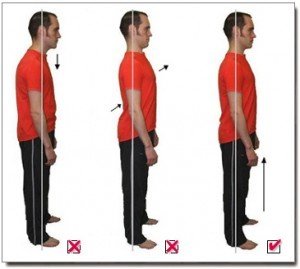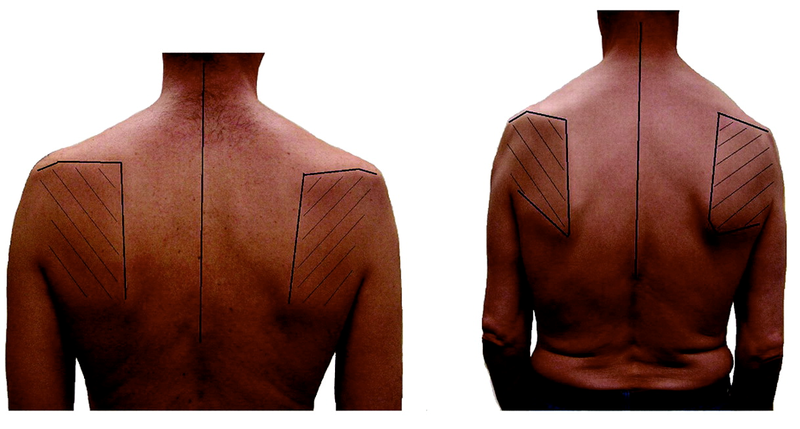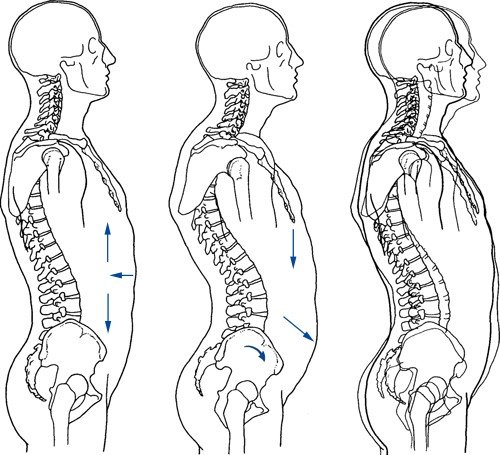There are no absolute methods of preventing injuries. However, some athletes do seem to be more readily injured than others. What patterns do these athletes exhibit that causes them to have more time out of the water than is necessary? I would suggest (for sake of ease of remembering 3 valid points) labelling them the 3 Ps:
Posture
Proprioception and Control
Preparation
Posture
Disability swimming is a sport where many of the athletes find that a ‘normal posture’ is almost impossible.

In a non-disabled individual, there is an ‘ideal’ postural position that is theoretically attainable by all (based on studies of medical students in the 1920’s and 1930’s) that does not take into account developmental or genetic variations. Many of the athletes on a World Class Programme are unable to achieve this position in full due to their disabilities; however there are still some areas that regardless of disability should be manageable.
For example: Head on neck posture: straight, not forward.

Shoulder blade position: flat against the chest wall rather than
winging away where possible.


The picture demonstrates the wide-reaching postural changes following on from excessive forward tilt of the pelvis (note position of shoulders and neck). Whilst these might not all be manageable on both sides in all areas for disabled athletes, an attempt to be as close to the optimum position is the goal.
Why is this important?
When we are in a position as close to the ideal postural position as possible, muscles are able to work at their most efficient as they will be at optimal length for function. Once an athlete gets into the pool for training, good technique means that, for the most part, the body returns to a more efficient position for the task in hand. This is good for the 2-4 hours per day of training, but does not take into account the rest of the athlete’s day (e.g. if they are at school, how do they sit for the time they are in class? If they are at work, is their workstation set up efficiently? If they are tall, do they regularly stoop to talk to peers or to not stand out? Are they slouching on a sofa when they are at home?).
Maintaining good posture through the day leads to the body’s default setting for training being closer to the optimum muscular length for activity: work will be more efficient with less risk of overloading sensitive structures.
If during the other 20 hours of a day the athlete’s posture is not ideal then they are leaving themselves open to compromising their posture, potentially their technique in the water and are therefore at greater risk of injury.
Proprioception and Control
Proprioception is defined as ‘the sense of relative positioning of neighbouring parts of the body’. It is a sensory modality that provides feedback on the status of the body. In basic terms, this means how we receive information on where our body is in space. The ability to know where a joint is within its normal range and ability to control it effectively is often referred to as joint positional sense (JPS). If our posture is good, then it is important that we are able to control our body in this position, recognise when we fall away from it and know that we can correct to the right position. Taking the example of the shoulder joint, if we are able to control rotation of the humeral head in socket, then the joint capsule that helps support the shoulder (and contains the ligaments that passively restrain the humeral head) will remain unstressed. If there is a lack of control in any direction that can repeatedly overload the shoulder capsule, which can lead to passive instability and significant discomfort. Good JPS and an ability to control the joint within a given range will prevent overload of tissues in this area.
Proprioception is not solely limited to the shoulder though. Control of lower back position is very important in both competition, training and day-to-day lifestyle to help reduce the risk of pain or damage. Control of knee position so that there is no hyperextension and overloading in standing means that structures won’t be overloaded through the day to reduce discomfort in training and competition.
An awareness of when the body falls away from the individual’s ideal position and an understanding of how to correct it is very important to reduce the many little strains that can build up to a big enough issue to require time out of the pool.
Many neurological disabilities (e.g. cerebral palsy, multiple sclerosis) will have an impact on an individual’s ability to recognise where their body is in space, compromising JPS. The ability to develop this can also be compromised; however it is possible to improve this skill. How much will vary hugely on severity of disability, comprehension and motivation, especially when this is a difficult task which requires a lot of application.
Preparation
This means preparation at all levels. Not only is it preparation for each individual training session, but also preparation for upcoming training changes.
Preparation for each training session requires preparing the body for the upcoming task. If the focus of the session is distance, it is important to be ready to get in the water having activated most of the type 1 muscle fibres (slow activation, preparation for getting the body flat in the water, good control of the shoulder joint so that for long periods of time the joint is accurately controlled). Similarly if the main focus is speed development, keeping the body flat and then targeting faster twitch muscles around the shoulders and hips to prepare for quicker work. This can be done with increasing the rate of turnover of shoulder warm-up exercises whilst maintaining good form, quicker rate of glutes work.
Preparation for upcoming training
sessions needs to be planned into land training prior to the beginning of the
new focus of training. If the focus of a block of training moves from, for
example, volume to speed and there has been no speed work programmed into land
training to prepare for the new training block, then the change in speed of
turnover without adequate preparation can lead to higher risk of injury. Land
based preparation in this way can also have positive performance benefits as
well as injury prevention.
SUMMARY
Posture: encourage as good posture as possible through the day and reinforce during sessions.

